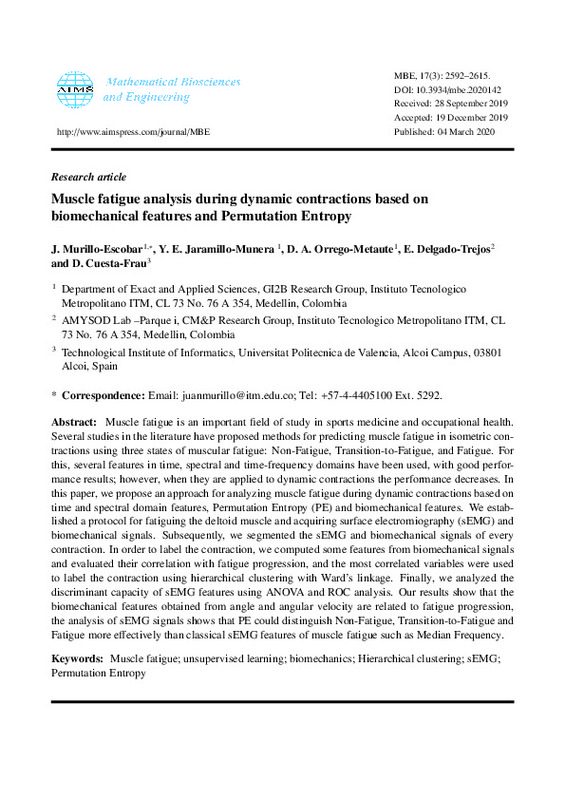JavaScript is disabled for your browser. Some features of this site may not work without it.
Buscar en RiuNet
Listar
Mi cuenta
Estadísticas
Ayuda RiuNet
Admin. UPV
Muscle fatigue analysis during dynamic contractions based on biomechanical features and Permutation Entropy
Mostrar el registro sencillo del ítem
Ficheros en el ítem
| dc.contributor.author | Murillo-Escobar, J.
|
es_ES |
| dc.contributor.author | Jaramillo Munera, Y. E.
|
es_ES |
| dc.contributor.author | Orrego-Metaute, D. A.
|
es_ES |
| dc.contributor.author | Delgado-Trejos, E.
|
es_ES |
| dc.contributor.author | Cuesta Frau, David
|
es_ES |
| dc.date.accessioned | 2021-09-04T03:40:47Z | |
| dc.date.available | 2021-09-04T03:40:47Z | |
| dc.date.issued | 2020 | es_ES |
| dc.identifier.issn | 1547-1063 | es_ES |
| dc.identifier.uri | http://hdl.handle.net/10251/171414 | |
| dc.description.abstract | [EN] Muscle fatigue is an important field of study in sports medicine and occupational health. Several studies in the literature have proposed methods for predicting muscle fatigue in isometric contractions using three states of muscular fatigue: Non-Fatigue, Transition-to-Fatigue, and Fatigue. For this, several features in time, spectral and time-frequency domains have been used, with good performance results; however, when they are applied to dynamic contractions the performance decreases. In this paper, we propose an approach for analyzing muscle fatigue during dynamic contractions based on time and spectral domain features, Permutation Entropy (PE) and biomechanical features. We established a protocol for fatiguing the deltoid muscle and acquiring surface electromiography (sEMG) and biomechanical signals. Subsequently, we segmented the sEMG and biomechanical signals of every contraction. In order to label the contraction, we computed some features from biomechanical signals and evaluated their correlation with fatigue progression, and the most correlated variables were used to label the contraction using hierarchical clustering with Ward's linkage. Finally, we analyzed the discriminant capacity of sEMG features using ANOVA and ROC analysis. Our results show that the biomechanical features obtained from angle and angular velocity are related to fatigue progression, the analysis of sEMG signals shows that PE could distinguish Non-Fatigue, Transition-to-Fatigue and Fatigue more effectively than classical sEMG features of muscle fatigue such as Median Frequency. | es_ES |
| dc.language | Inglés | es_ES |
| dc.relation.ispartof | Mathematical Biosciences and Engineering | es_ES |
| dc.rights | Reconocimiento (by) | es_ES |
| dc.subject | Muscle fatigue | es_ES |
| dc.subject | Unsupervised learning | es_ES |
| dc.subject | Biomechanics | es_ES |
| dc.subject | Hierarchical clustering | es_ES |
| dc.subject | SEMG | es_ES |
| dc.subject | Permutation Entropy | es_ES |
| dc.subject.classification | ARQUITECTURA Y TECNOLOGIA DE COMPUTADORES | es_ES |
| dc.title | Muscle fatigue analysis during dynamic contractions based on biomechanical features and Permutation Entropy | es_ES |
| dc.type | Artículo | es_ES |
| dc.identifier.doi | 10.3934/mbe.2020142 | es_ES |
| dc.rights.accessRights | Abierto | es_ES |
| dc.contributor.affiliation | Universitat Politècnica de València. Departamento de Informática de Sistemas y Computadores - Departament d'Informàtica de Sistemes i Computadors | es_ES |
| dc.description.bibliographicCitation | Murillo-Escobar, J.; Jaramillo Munera, YE.; Orrego-Metaute, DA.; Delgado-Trejos, E.; Cuesta Frau, D. (2020). Muscle fatigue analysis during dynamic contractions based on biomechanical features and Permutation Entropy. Mathematical Biosciences and Engineering. 17(3):2592-2615. https://doi.org/10.3934/mbe.2020142 | es_ES |
| dc.description.accrualMethod | S | es_ES |
| dc.relation.publisherversion | https://doi.org/10.3934/mbe.2020142 | es_ES |
| dc.description.upvformatpinicio | 2592 | es_ES |
| dc.description.upvformatpfin | 2615 | es_ES |
| dc.type.version | info:eu-repo/semantics/publishedVersion | es_ES |
| dc.description.volume | 17 | es_ES |
| dc.description.issue | 3 | es_ES |
| dc.identifier.pmid | 32233556 | es_ES |
| dc.relation.pasarela | S\401358 | es_ES |
| dc.description.references | 12. M. Tian, Y. Ozturk, S. Sun, Y. Su, Measurement of upper limb muscle fatigue using deep belief networks, <i>J. Mech. Med. Biol.</i>, 16 (2016) 1-18. | es_ES |
| dc.description.references | 13. N. A. Kamaruddin, P. I. Khalid, A. Z. Shaameri, The use of surface electromyography in muscle fatigue assessments: A review, <i>Jurnal Teknologi</i>, 74 (2015), 1-5. | es_ES |
| dc.description.references | 22. D. Cuesta-Frau, M. Varela-Entrecanales, A. Molina-Picó, B. Vargas, Patterns with equal values in Permutation Entropy: Do they really matter for biosignal classification?, <i>Complexity</i>, 2018 (2018), 1-16. | es_ES |
| dc.description.references | 24. M. Brzycki, Strength testing: Predicting a one-rep max from repetitions to fatigue, <i>J. Phys. Educ.</i> <i>Recreat. Dance</i>, 64 (1993), 88-90. | es_ES |
| dc.description.references | 26. G. Staude, Onset detection in surface electromyographic signals: A systematic comparison of methods, <i>EURASIP J. Adv. Sig. Pr.</i>, 2001 (2001), 67-81. | es_ES |
| dc.description.references | 33. C. Bandt, B. Pompe, Permutation Entropy: A natural complexity measure for time series, <i>Phys.</i> <i>Rev. Lett.</i>, 88 (2002). | es_ES |
| dc.description.references | 35. M. Riedl, A. Müller, N. Wessel, Practical considerations of permutation entropy: A tutorial review, <i>Eur. Phys. J.</i>, 222 (2013), 249-262. | es_ES |
| dc.description.references | 47. J. Augustsson, R. Thomeé, C. Lindén, M. Folkesson, R. Tranberg, J. Karlsson, Single-leg hop testing following fatiguing exercise: Reliability and biomechanical analysis, <i>Scand. J. Med. Sci.</i> <i>Sports.</i>, 16 (2006), 111-120. | es_ES |
| dc.description.references | 48. J. L. R. Jayalath, N. Weerakkody, R. Bini, Effects of fatigue on ankle biomechanics during jumps: A systematic review, <i>J. Electromyogr. Kinesiol.</i>, 42 (2018), 81-91. | es_ES |
| dc.description.references | 53. K. S. Urbinati, A. D. Vieira, C. Papcke, R. Pinheiro, P. Nohama and M. Scheeren, Physiological and biomechanical fatigue responses in Karate: A case study, <i>Open Sports Sci. J.</i>, 10 (2017), 286-293. | es_ES |








